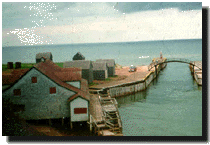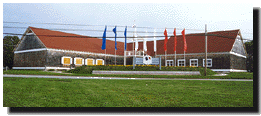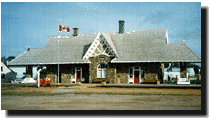
The “Island Way of Life” is
deeply rooted in traditional livelihoods that gradually
expanded and evolved to become the major industries that
exist today. Early European settlement, pioneer life,
fishing, farming, shipbuilding, the railway, rural
schools; Prince Edward Island life revolved around these
institutions during the 1800s. This heritage is kept
alive in many historic buildings and museums across the
province.
The Sea
Surrounded by water, Islander’s livelihoods have
been greatly influenced by the sea. The Basin  Head Fisheries Museum
depicts the way of life for Islanders engaged in the
inshore fishery. Featuring, salt water aquariums,
traditional fishing gear, photographs, and dioramas
illustrating fishing methods and coastal ecology. Another
aspect of fishing is presented for our educational and
gastronomic enjoyment at the Irish Moss Interpretive
Centre and the Seaweed Pie Café in Miminegash.
Head Fisheries Museum
depicts the way of life for Islanders engaged in the
inshore fishery. Featuring, salt water aquariums,
traditional fishing gear, photographs, and dioramas
illustrating fishing methods and coastal ecology. Another
aspect of fishing is presented for our educational and
gastronomic enjoyment at the Irish Moss Interpretive
Centre and the Seaweed Pie Café in Miminegash.
Prince Edward Island’s first lighthouse was built in
1846 at Point Prim, the Eastern entrance to Hillsborough
Bay and Charlottetown Harbour from the Northumberland
Strait. The Point Prim Lighthouse is one of the many that
are open to visitors during the summer months. The
lighthouses at East Point and at West Point are among the
few remaining manned lighthouses on Prince Edward Island.
During the 19th century, the shipbuilding industry
brought great prosperity and created an international
reputation for the Island as our forest cover was cut to
build wooden ships for the British Navy. Green Park
Shipbuilding Museum and Yeo House trace the history of
shipbuilding in the 1800s and feature the restored home
of Port Hill shipbuilding magnate James Yeo. In
Charlottetown, Beaconsfield Historic House, (1877) was
the home of James Peake, Jr., another wealthy
shipbuilder. Today, Beaconsfield hosts lectures and
special events throughout the year and houses the
headquarters of the Prince Edward Island Museum and
Heritage Foundation. Its rooms and furnishings are
restored to the Victorian style with a veranda and garden
overlooking the Charlottetown
Harbour.
Farming and Community Life
 Since the 1770s, the
overwhelming majority of Islanders have been engaged in
farm-related activity, with oats and potatoes
constituting the Island’s primary export products.
Today, agriculture remains Prince Edward Island’s
most important industry. In O’Leary, Prince Edward
Island’s primary agricultural export is given a
place of honour at the Prince Edward Island Potato
Museum. This facility, which is Canada’s only potato
museum, displays artifacts, photographs, a collection of
farm equipment and an interpretive display on the potato
industry in Prince Edward Island.
Since the 1770s, the
overwhelming majority of Islanders have been engaged in
farm-related activity, with oats and potatoes
constituting the Island’s primary export products.
Today, agriculture remains Prince Edward Island’s
most important industry. In O’Leary, Prince Edward
Island’s primary agricultural export is given a
place of honour at the Prince Edward Island Potato
Museum. This facility, which is Canada’s only potato
museum, displays artifacts, photographs, a collection of
farm equipment and an interpretive display on the potato
industry in Prince Edward Island.
The role of the fox-farming industry brought a
short-lived but significant period of prosperity to
Prince Edward Island’s economy between the 1870s and
the 1920s. The International Fox Museum and Hall of Fame
Inc., located in the historic Holman homestead in
Summerside, recounts the story of these silver fox years.
South Rustico’s Farmer’s Bank Museum was the
site of one of the first people’s banks in Canada. A
precursor to the Credit Union movement, the bank provided
cheap credit, enabling the largely Acadian community of
farmers and fisherman, to achieve economical
independence.
The province’s rural,
agricultural heritage is recreated in two historical
villages. One, the Orwell Corner Historic Village
features an 1864 farmstead and community buildings. At
this historic village late nineteenth century farm
practices and community festivities are revived
throughout the planting and harvest seasons. Two, the
Acadian Pioneer Village, in Mont Carmel, reproduces an
Acadian settlement of the 1820s, complete with log homes,
a church, workshops, and a school.

The Acadians’ 300-year history is further
represented at the Acadian Museum in Miscouche. The
museum features permanent and temporary exhibits, audio
visual displays, and genealogy resources. The collection
portrays the history, culture, and development of the
Island’s Acadian population through many setbacks
and obstacles.
Prince Edward Island’s heritage of one-room
schoolhouses is commemorated in the Skinner’s Pond
Schoolhouse and Union Corner School House Museum, which
was originally built in 1794. Historic Fanning School at
Cabot Beach is exceptional in that it was a two-storey
building.
Several localities across Prince Edward Island have
established museums that depict rural Island life during
the eighteenth and nineteenth centuries. They tell the
story of the Mi’kmaq, early pioneers, farming,
fishing, and family life. Some of these museums include:
the Alberton Museum, the Keir Memorial Museum in
Malpeque, Montague’s Garden of the Gulf Museum, and
Murray Harbour’s Log Cabin Museum.
The Railway
The colony of Prince Edward Island began construction of
a 147-mile railway system uniting communities from
Elmira, near the eastern-most tip of the Island,  through Kensington, all the
way to Alberton in the west. Kensington’s was one of
the few stone stations built in Prince Edward Island. Now
a national historic site it has been restored to its
original splendour and contains historical displays
reviving our Island railway heritage. The Elmira Railway
Station museum displays a map of the rail system, a
re-created station-master’s office and a
ladies’ waiting room.
through Kensington, all the
way to Alberton in the west. Kensington’s was one of
the few stone stations built in Prince Edward Island. Now
a national historic site it has been restored to its
original splendour and contains historical displays
reviving our Island railway heritage. The Elmira Railway
Station museum displays a map of the rail system, a
re-created station-master’s office and a
ladies’ waiting room.
National Park
| Historic Sites
| Scenic Heritage Roads |
Historic
Buildings and Churches | Monuments
to Our Past
